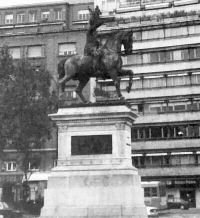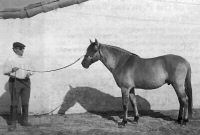
Three Eagles / Drs. McCormick
History
Seminars and More
Corporate Opportunities
|
|
|
Our personal and professional travels led us to many interesting places and people, to some of the leading Equine authorities on the Iberian Peninsula, the European Continent, the Celtic Isles, North Africa and North America. Breeds evolve, so to understand the Peruvian horse we must gaze into its distant past. Thousands of years ago a unique type of horse came thundering onto the world stage. In ancient horse-cultures such as the Celts, Scythians, Mongolians, Greeks, Persians, etc. they domesticated horses for specific reasons. Hunting, travel, war and particularly conquest were some of the primary reasons. Eventually, an Indo-European horse skilled at skirmish style warfare emerged. This Skirmish horse eventually landed in Spain as a result of the Celts, an Indo-European tribe. Predating this Indo-European horse used by the Celts, Persians, Greeks and Iberians, the Scythians and Mongols had a similar type of horse and advanced riding style. Excellent riding style was the difference between life and death for many of these tribes. THE ANCIENT SKIRMISH STYLE HORSE This ancient horse had an aptitude for maneuverability and an ability to become air-born for warfare movements which required attack and retreat. The Iberians eventually discovered the rare capabilities of this horse and began their own breeding campaign. Besides skirmish style warfare the Spanish desired a horse that could work bulls and navigate the rocky terrain of the Iberian Peninsula by remaining balanced and collected. Hence, a Spanish/Iberian type emerged. This is why breeders of all Spanish blooded horses today desire a square horse instead of a rectangular horse and a horse with brio (willing, hot and tractable temperament) and natural collection. They did not need a horse for speed. The Iberians also found this ancient horse to have a keen mind which gave it the intelligence to become versatile. While in Spain the blood of this ancient horse was further infused with blood from the Barb in Morocco, the Celtic horse (called the Galician or Austurian found in the north of Spain called Celt-Iberia) and the Sorraia, a wild horse found in Portugal. THE PERUVIAN HORSE-THE HORSE OF SPANISH CONQUERORS The horse of the Iberian Peninsula is called by many different names such as the Andalusian, the Luisitano, the Castillian, Gineta, Jinete, Pura Raza Espanol. Since it was the finest riding and military horse in the world it was used by Spain during the conquest of the Americas. Eventually the horse of the Spanish Conquerors was given new names, such as Peruvian horse, as the various countries colonized and gained their independence. In essence, the Peruvian Horse that we know today is an antique Andalusian from the 15th century with a gait. Pizarro was a horseman. He would only ride the very best of horses. It is well documented that the Spanish Conquistadors brought with them both Hacks (amblers) and Chargers (trotters) of the same breed to the New World, as recorded in the Archives of the Indios, the Spanish Horse was (and still is) a breed consisting of Galician/Asturian (Celtic) horses of the North, Sorraia horses, and Barb horses from Morocco. Arriving in the New World horsemen in those days often traveled as much as a “full thirteen leagues” (39 miles) which is not a bad journey for those who had only a single horse and were not certain of the road. The gait they used for travel was called “Castillian Pace” or running walk, or in Peruvian horse jargon in modern times…. Paso Llano. Cuban historian and analyst Jorge DeMoya indicates that “Paso Llano is actually a contraction of Paso Castellano, a smooth way of going.” THE PERUVIAN GAIT The Peruvian gait comes directly from its Iberian ancestry. While in Spain we discovered that many Andalusian horses still had a propensity to amble and it is those horses that the Peruvians selected to breed to one another to get the broken lateral gait. The Spanish breeders of today still want high lift which is also a characteristic of the Peruvian horse. Throughout Spain there are many old statues of the Spanish horse with high lift and gait.
It is common knowledge that the first group of horses brought from Spain by Columbus to the New World were Sorraias. The Sorraia, a strong and rustic horse, one of the wild predecessors of modern Iberian breeds, proved to be very tough for this kind of uncharted territory.
Later, however there were many shipments of prized Andalusian horses and soon, breeding farms were being established in the New World and began thriving. Columbus set out from the Puerta de Santa Maria on his second trip to the West Indies (Caribbean Islands) with horses, mares and stallions to set up Criadores (Breeding Farms). These breeding farms were to be found on what is now the Dominican Republic, Puerto Rico and as far South as Panama. It was in Panama that Pizarro charted his voyage to Peru taking many of these horses with him. Spanish breeders settled in these islands and Panama, to sell horses, especially to Spanish Conquerors, both in Mexico and Peru. So important were the noble horses of the Conquistadores that Bernal Diaz gives a description with their colors, merits, and faults before he wrote about any of his inimitable stories of conquerors. Bernal Diaz, a chronicler, writes for the conquistadors of the horses as friends and comrades. When a horse was wounded or killed he writes, "The conquest was victorious because of the horses, after God.” THE PERUVIAN HORSE IN MODERN TIMES Peru has had a tumultuous history with much political upheaval and war. Yet, with all its problems Peru is like the proverbial Phoenix rising from the ashes. For this reason prior to 1945 many names and dates relating to horses in Peru are virtually non-existent. Most records were lost during the Chilean War. The Chileans not only won the War of Pacific, 100 years ago but they also occupied Peru after the victory. This situation proved to be devastating to both the people and the horses of Peru, most particularly those in the South since it borders Chile. During the war and occupation Chile not only killed horses and trainers (considered military experts) but they also burned most of their records. The Peruvian breeders fearing for the lives of their most esteemed animals set many of them free in the Andes. They hoped to retain these lines for the future and save them. Sol de Oro Viejo is presumed to be one of the offspring of these horses and for this reason finding him in the mountains must have been cause for great elation. Many who saw him reported they recognized him as old Spanish blood and interestingly enough he gaited and trotted. In the post war era after the Chilean occupation Peru began to recover. In approximately 1935 once Peru began to regain its independence and restore its equilibrium, agriculture began to flourish once again. As part of this recovery in 1945, Peru made an all out effort to preserve their treasure, almost lost. Peruvians made a serious attempt to record the horses' fabulous history and guard their legacy. It was at this time they decided to have shows, form an association and start a stud book. Then tragedy struck again when the government implemented a program called the Agrarian Reform in the 1960’s. The political powers decided to seize land from the patrons by force and redistribute it. Many of these patrons/horse breeders had been successful agriculturalists for generations. Overnight their haciendas were taken away from them at gun point, under the threat of death. Many had to flee in the middle of the night. Some left with just the clothes on their backs and ran with their families and horses over the boarder into other countries. It was a dark period in Peru. Those who were lucky enough to retain their lands lived under a constant threat. Since horses are always viewed as a ‘luxury’ during a government takeover the beloved horses were under siege as well. Some were confiscated; herds lay dead in the fields from lack of government care, others were set free by their owners to run for their lives. There were instances of breeders who hid their horses from government thugs, sequestering their favorite horses inside their haciendas. The Peruvian breeders endured unimaginable conditions and made many sacrifices to protect the Peruvian horse out of a deep sense of love. There are endless accounts of breeders who risked their own lives to save their equine friends. These horse breeders proved what it means to be courageous and honorable. Today Peru’s economy is good and the horses are thriving. Yet, we owe many thanks to the Peruvian Breeders and their families who endured so much suffering so the world could encounter the Peruvian horse, a treasure from the ancient past. In summary, the Peruvian horse has all the characteristics of his Iberian ancestors: conformation, temperament, natural collection and grand movement, albeit it lateral or diagonal. The Peruvian breeders' genius lay in their maintaining the purity of their Spanish horses and its lateral gait. Resources: Pedro garcia Conde, "Verdadera Albeiteria" Maestro Harrador, y Albeytor mas Antiquo, De La Real Cavallerja. "The Horse of the Conquest," R.B. Cunninghame Traham (Don Roberto) Wm Heineman, Ltd. 1930.
Garcilasco de la Vega, el Ivea. Madrid - Archueve Le Vidios 1723. 'd Andrade, Antonio, Arte Cavallania de quenta e estradiota Lisbon, 1678. Zarate, Augustin de: Historia de decubrirmento y Conquestor de la provincia del Peru, Madrid 1826 - Archives. Muchuca, Bernado de Vargas, Libro de Excicious de la Gineta. Madrid 1500. Loch, Lady Sylvia, The Royal Horse of Europe, J. A. Allen, London 1986. de la Gueriniere, School of Horsemanship, Translated by Doucher, Allen, London 1994. Daniels, Rick, Controversy, Oh, Controversy, Caballo Magazine, Vol. 9 Number 59, 1996. Historia General - Antonia de Herrera y Tordisillas Madrid 1726.
Call for more information and prices: (830) 980-8453 |
Last Updated: February 2, 2017
Website Design: Deborah McCormick and Gary Poss

 .
.